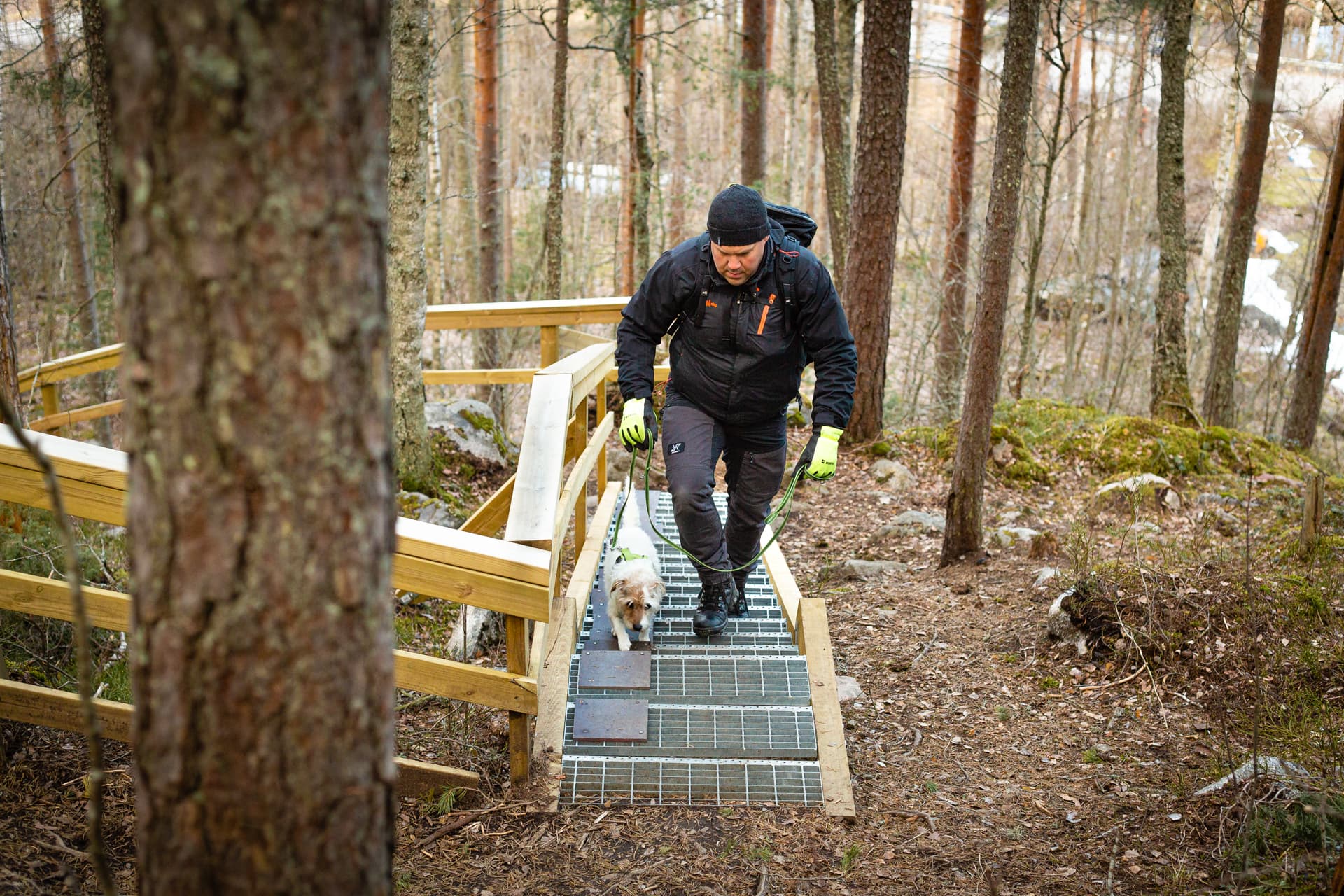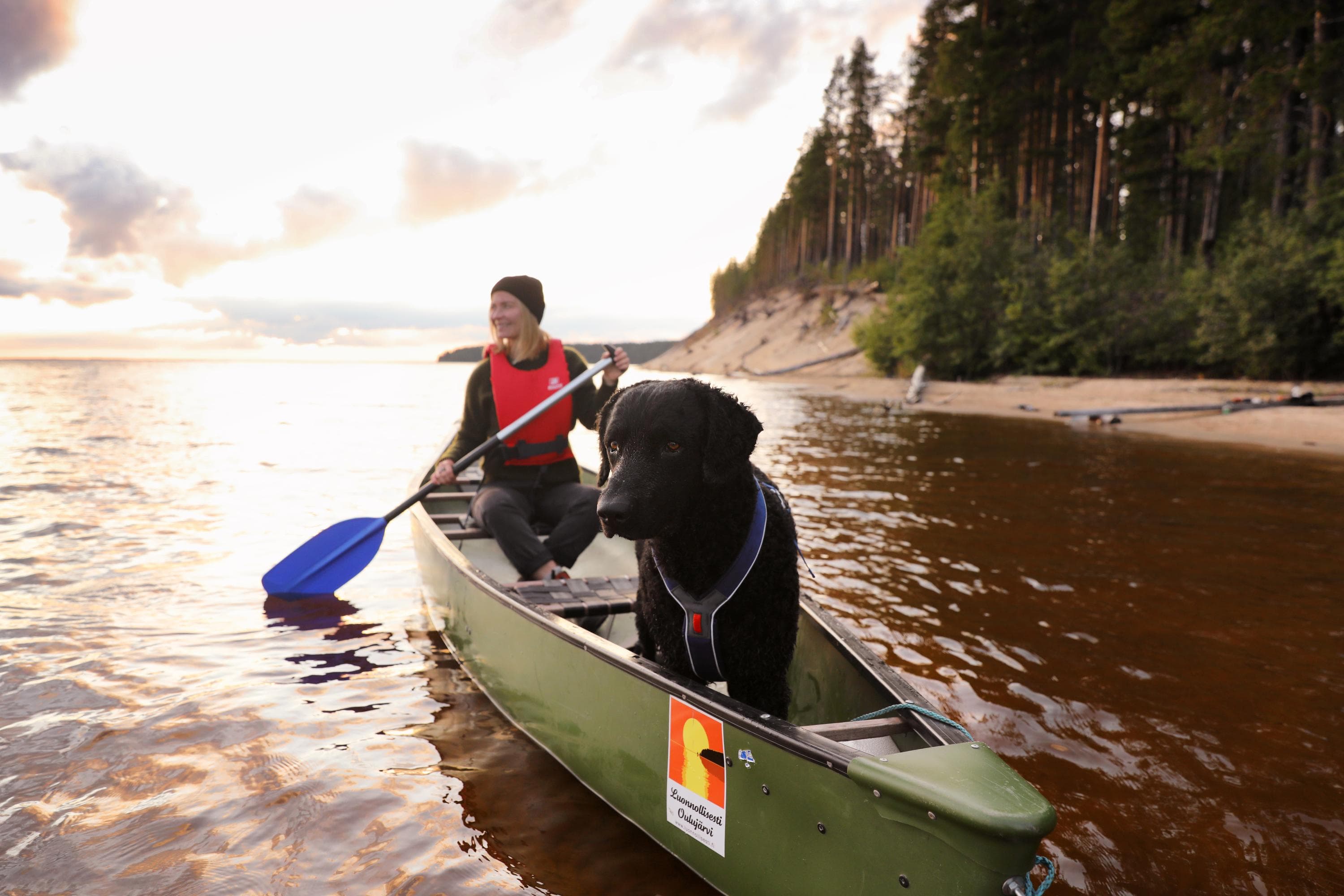Where can you go hiking with a dog?
You can hike with your dog in most areas as long as you follow public order and hunting laws, as well as the specific rules of nature reserves. In national parks and other protected areas, dogs must always be kept on a leash. When exploring nature with your dog, consider not only your dog but also other people and wildlife.
In reindeer husbandry areas, extra caution is necessary. Reindeer instinctively perceive dogs as predators – barking and running can cause severe stress. In late winter and early summer, reindeer are particularly vulnerable: disturbances during calving may result in the death of calves. A dog’s presence can also disrupt herding work, drive reindeer to the wrong areas, and cause additional labor and costs. Approaching reindeer with a dog, even for photography, is always forbidden.
Preparing for a hike
Start with short day trips, especially if you or your dog have no previous hiking experience. Short hikes help your dog get used to the terrain and situations that come with hiking.
For a day trip, your dog only needs a collar or harness, leash, a bowl, and its own food. Make sure your dog stays well hydrated – water balance is just as important for dogs as it is for people.
Longer hikes require good fitness from both dog and owner. A dog’s food takes up space in the backpack and adds weight. In some cases, a dog can carry its own food in a well-fitting dog backpack, but it must be trained to wear it in advance.
Useful skills for a hiking dog
Helpful skills for hiking dogs include leash manners, passing other hikers and dogs calmly, appropriate behavior during breaks, and sleeping in a tent. At rest areas, the dog should be able to wait calmly on a leash a little away from the fire site.
The dog should be used to moving on various surfaces – such as grates, suspension bridges, and rough terrain. Begin training early and expose your dog to varied conditions from a young age.
The owner carries the dog's gear and shelter. You must always bring your own tent or similar shelter, as pets are not allowed in all huts.

When should the dog stay home?
Not all dogs are suited for hiking. Leave your dog at home if it is very young, old, ill, easily stressed, or unpredictable. Hiking is not enjoyable if the dog does not like being outdoors in all weather. During the peak mosquito season, at least short-haired dogs should stay home.
On the trail
A hiking day starts and ends with some warm-up activity for the dog. Schedule drink and rest breaks, and remove the dog’s backpack during longer pauses. On hot days, frequent hydration and adjusting your pace is essential. Regularly check your dog’s paws and the fit of the pack. Training and careful adjustments are necessary for using a dog backpack.
After a long hike, the dog needs rest. Gradually switch back to your dog’s regular food by mixing it with the hiking food.
Overnight stays
Always bring your own shelter when staying overnight – dogs are not allowed in all open wilderness huts or reservable huts due to allergy concerns. Check each hut’s rules in advance on their website.
Get your dog used to sleeping in a tent before the trip. Decide whether the dog will sleep in the inner tent or vestibule. Protect your dog from cold, moisture, and insects. A jacket or warm sleeping pad may be necessary for short-haired dogs.
Equipment for longer hikes with a dog
- Collar or harness and leash (extra leash or chain if needed)
- Travel bowl, food, and treats
- Coat or sleeping mat if the dog gets cold easily
- Dog boots and paw balm for potential injuries
- Brush and towel
- Possible backpack that fits the dog well and is balanced
- Identification tags on the collar
Food and water
Choose familiar dry food or a more energy-dense hiking food. For short trips of 1–2 days, the dog's usual dry food is suitable. On longer hikes, the dog's energy needs increase compared to everyday life. Therefore, consider a lighter option that is easier to carry, such as freeze-dried or dehydrated meat products, which are both high in energy and lightweight. Gradually introduce the dog to the new food well before the trip.
Make sure the dog gets enough water – maintaining hydration is essential for the dog’s well-being. If there are no natural water sources along the planned route, carry enough water for the dog as well. In winter, melt snow for water or mix warm water into the food.
During car journeys, never leave the dog in a parked car during summer, as the temperature inside the car can rise dangerously high, risking heatstroke. If you must leave the dog briefly, tie it outside in the shade and provide a water bowl. In the forest, make sure not to tie the dog near ant trails or, in northern areas, where midges and blackflies may bite.
First aid
It is advisable to pack the following items in the dog’s first aid kit:
- Wound ointment, possibly also hydrocortisone
- Cleaning and bandaging materials
- Tick remover, insect repellent
- Anti-diarrhea medication
- Snakebite kit for allergic reactions. Note: Antihistamines should never be given for a snake bite – always take the dog to a veterinarian in such cases.
- Any necessary medications and a carrying aid for emergencies.
On the water with a dog
In a boat or canoe, the dog must remain calm and wear its own life jacket. Protect the dog from the sun and ensure access to drinking water. Also, keep in mind that even on islands, the dog should not be allowed to run free – exercise breaks should always be supervised.

Winter hiking
Winter hiking is more demanding for both the dog and the owner. Snow does not always support the dog's weight, making progress challenging. Dogs with short coats need an insulated coat and a warm sleeping mat. It is advisable to get the dog used to cold weather already in autumn so that the coat has time to thicken.
Proper gear is crucial during winter overnight stays, and the planning must take into account both the dog’s and owner’s needs. Starting with easier routes is a good idea to gain experience.
Crossing national borders
When hiking in Finnish Lapland or the archipelago, state borders may be difficult to notice. However, when traveling with a dog, remember that taking a dog to Norway or Sweden is strictly regulated. The dog must have a pet passport issued by a veterinarian, including certification of identification, vaccinations, and deworming. All import and export regulations can be found on the website of the Finnish Food Authority (ruokavirasto.fi). When traveling to Sweden, you must also report the dog to the Swedish Customs (tullverket.se).
Check list for hiking with your dog
- Dogs must always be kept on a leash in national parks and other nature conservation areas. Even a well-behaved dog must be kept on a leash to set a good example if nothing else.
- National parks are protected areas where plants and animals must be left alone. Allowing your dog to run free in a national park is prohibited by the law at all times of the year. This can cause damage to young birds and other animals simply by scaring them.
- In reindeer husbandry areas, dogs may get excited by the reindeer, which can exhaust weak calves even when the dog just wants to have a bit of fun. The barking of a dog can also hamper reindeer husbandry work by frightening the reindeer and causing them to run in the wrong direction.
- Let your dog fetch sticks and dig holes before you enter the national park. Digging holes and pulling twigs and branches off dead trees is forbidden in national parks and other nature reserves – and this also applies to dogs. For example, dead trees provide a home for many threatened insects.
- Do not disturb other hikers. Not everyone likes dogs and some people may be afraid of them.
- Please pick up your dog’s waste and keep the trails clean. When out and about, you can use a branch to sweep dog poo into the forest. In yard areas you must collect it in a bag and put it in a mixed waste bin. Do not leave dog waste bags on tracks or paths.
- Check to find out if dogs are allowed in the huts. The pet rules for open wilderness, rental and reservable huts vary by region. (You can find the hut-specific rules on the website for each hut).
- People accompanied by guide or assistance dogs have a statutory right to access all locations. This also applies to Metsähallitus huts, visitor centres and restaurants.
- As a general rule, dogs must be kept on a leash everywhere except in your own yard and in dog parks. Find out more about the regulations in the Public Order Act (finlex.fi) and Hunting Act (finlex.fi).